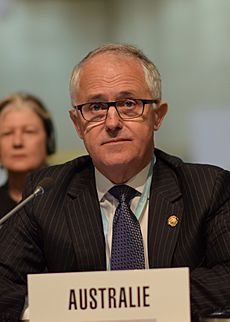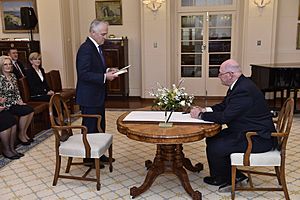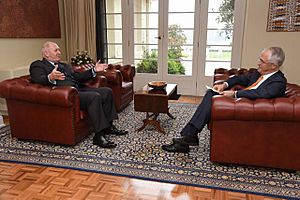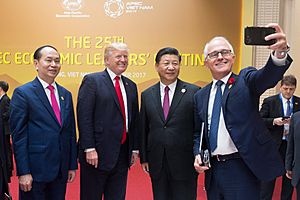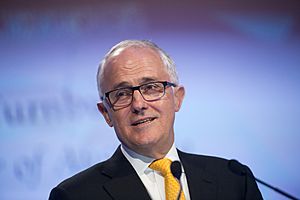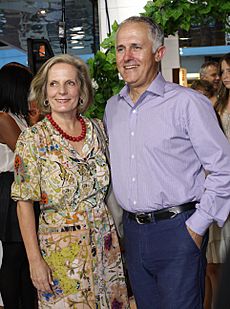Malcolm Turnbull facts for kids
Quick facts for kids
Malcolm Turnbull
|
|
|---|---|
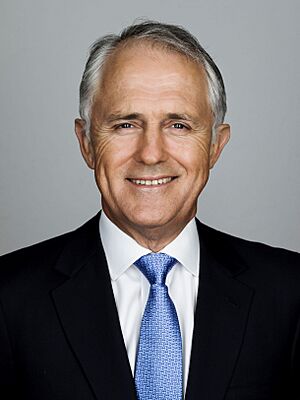
Official portrait, 2015
|
|
| 29th Prime Minister of Australia | |
| In office 15 September 2015 – 24 August 2018 |
|
| Monarch | Elizabeth II |
| Governor General | Sir Peter Cosgrove |
| Deputy | Warren Truss Barnaby Joyce Michael McCormack |
| Preceded by | Tony Abbott |
| Succeeded by | Scott Morrison |
| Leader of the Opposition | |
| In office 16 September 2008 – 1 December 2009 |
|
| Prime Minister | Kevin Rudd |
| Deputy | Julie Bishop |
| Preceded by | Brendan Nelson |
| Succeeded by | Tony Abbott |
| 12th Leader of the Liberal Party | |
| In office 14 September 2015 – 24 August 2018 |
|
| Deputy | Julie Bishop |
| Preceded by | Tony Abbott |
| Succeeded by | Scott Morrison |
| In office 16 September 2008 – 1 December 2009 |
|
| Deputy | Julie Bishop |
| Preceded by | Brendan Nelson |
| Succeeded by | Tony Abbott |
| Minister for Communications | |
| In office 18 September 2013 – 14 September 2015 |
|
| Prime Minister | Tony Abbott |
| Preceded by | Anthony Albanese |
| Succeeded by | Mitch Fifield |
| Minister for the Environment and Water | |
| In office 30 January 2007 – 3 December 2007 |
|
| Prime Minister | John Howard |
| Preceded by | Ian Campbell |
| Succeeded by | Peter Garrett |
| Member of the Australian Parliament for Wentworth |
|
| In office 9 October 2004 – 31 August 2018 |
|
| Preceded by | Peter King |
| Succeeded by | Kerryn Phelps |
| Chairman of the Australian Republican Movement | |
| In office November 1993 – 20 September 2000 |
|
| Preceded by | Tom Keneally |
| Succeeded by | Greg Barns |
| Personal details | |
| Born |
Malcolm Bligh Turnbull
24 October 1954 Sydney, New South Wales, Australia |
| Political party | Liberal |
| Other political affiliations |
Coalition |
| Spouse |
Lucy Hughes
(m. 1980) |
| Relations | Angela Lansbury (second cousin once removed) |
| Children | 2 |
| Parents | Bruce Turnbull Coral Lansbury |
| Education | Vaucluse Public School Sydney Grammar St Ives Preparatory School Sydney Grammar School |
| Alma mater | University of Sydney (BA, LLB) Brasenose College, Oxford (BCL) |
| Profession |
|
| Signature |  |
Malcolm Bligh Turnbull is an Australian former politician and businessman. He served as the 29th prime minister of Australia from 2015 to 2018. He was also the leader of the Liberal Party of Australia from 2008 to 2009 and again from 2015 to 2018. Before becoming prime minister, he was a member of parliament (MP) for the area of Wentworth in New South Wales from 2004 to 2018.
Born in Sydney, Turnbull studied at the University of Sydney and later at Brasenose College, Oxford, as a Rhodes Scholar. For over 20 years, he worked as a journalist, lawyer, and investor. He led the Australian Republic Movement from 1993 to 2000, which aimed to change Australia into a republic. He was first elected to the Australian House of Representatives in 2004.
Turnbull became the Leader of the Opposition in 2008. He later served as Minister for Communications in the government led by Tony Abbott. In 2015, he challenged Tony Abbott for the leadership of the Liberal Party and won, becoming prime minister. His government focused on innovation, science, and major infrastructure projects. In 2016, he led his party to win a federal election. During his time as prime minister, Australia also voted to allow same-sex marriage. He left politics in 2018.
Contents
Early Life and Education
Malcolm Bligh Turnbull was born in Sydney on 24 October 1954. He was the only child of Bruce Bligh Turnbull and Coral Lansbury. His father worked as a hotel broker. His mother was a radio actor, writer, and university teacher. Malcolm's middle name, "Bligh," is a family tradition.
When Malcolm was nine, his parents separated, and he was raised by his father. He attended Vaucluse Public School and later Sydney Grammar School. He found boarding school difficult at first. His father faced financial challenges paying school fees, but his business later improved. Malcolm excelled in subjects like Greek, English, and History. He was active in debating and drama clubs. In 1972, he became a senior school co-captain. In memory of his father, he later set up a scholarship at Sydney Grammar to help students who could not afford the fees.
In 1973, Turnbull began studying at the University of Sydney. He earned degrees in political science and law. During his studies, he wrote for the university newspaper, Honi Soit, often about politics. He also worked part-time as a political journalist for various media outlets.
In 1978, Turnbull received a Rhodes Scholarship, which allowed him to study at Brasenose College, Oxford in England. He earned a law degree there. While at Oxford, he worked for The Sunday Times and wrote for newspapers in the United States and Australia. He met his future wife, Lucy, during this time.
Professional Career
After finishing his studies at Oxford, Turnbull returned to Australia and started working as a lawyer. He worked for a large media company from 1983 to 1985.
Legal Work
In 1986, Turnbull started his own law firm, Turnbull McWilliam. A notable case he worked on was defending Peter Wright, a former British spy who wrote a book called Spycatcher. The British government tried to stop the book from being sold in Australia, but Turnbull successfully argued against this. The case was widely reported and made Turnbull well-known in Australia and the United Kingdom. He later wrote a book about the trial.
In 1987, Turnbull co-founded an investment banking firm called Whitlam Turnbull & Co Ltd. He later left this firm in 1997 to become a managing director at Goldman Sachs Australia, a major global investment bank.
Turnbull also invested in the internet service provider OzEmail in 1994. He sold his share in the company in 1999 for a significant amount of money.
Early Political Involvement
Turnbull had an interest in politics from a young age. He tried to become a Liberal Party candidate for the area of Wentworth in 1981 but was not chosen. He rejoined the Liberal Party in 2000 and became its Federal Treasurer.
Australian Republican Movement
In 1993, Prime Minister Paul Keating appointed Turnbull to lead a committee that looked into how Australia could become a republic. This would mean replacing the Queen of Australia with an Australian head of state. Later that year, Turnbull became the leader of the Australian Republic Movement, a group that supported this change. He held this position until 2000.
Turnbull was a strong supporter of the "Yes" campaign in the 1999 Australian republic referendum. This vote asked Australians if they wanted to become a republic. The "Yes" campaign was not successful. After the referendum failed, Turnbull left the Australian Republican Movement.
Joining Parliament
In 2003, Turnbull successfully became the Liberal candidate for the seat of Wentworth. He won the seat in the 2004 Australian federal election. This was a close election for Wentworth, which is usually a safe Liberal seat.
Howard Government
Cabinet Minister
In January 2006, Prime Minister John Howard promoted Turnbull to a special role focusing on water, during a time of severe drought in Australia. In January 2007, Turnbull was promoted to the Cabinet as Minister for the Environment and Water. In this role, he approved a large paper mill project in Tasmania, which had to meet strict environmental conditions.
Opposition
After the 2007 Election
Turnbull kept his seat in the 2007 Australian federal election, even though the Liberal Party lost the election. After John Howard lost his own seat, Turnbull ran for the leadership of the Liberal Party but narrowly lost to Brendan Nelson. Nelson then appointed Turnbull as the party's finance spokesperson.
Leader of the Opposition (2008–2009)
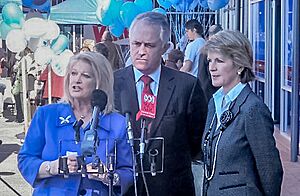
In September 2008, Turnbull challenged Brendan Nelson for the leadership of the Liberal Party and won. He then became the Leader of the Opposition.
In 2009, Turnbull faced a difficult situation known as the 'OzCar affair'. He made claims in Parliament based on information that later turned out to be false. This caused his public approval ratings to drop.
In November 2009, Turnbull announced his support for the government's plan to reduce carbon pollution, even though many of his party colleagues disagreed. This led to a challenge for his leadership. On 1 December 2009, Tony Abbott challenged Turnbull and won by just one vote. Turnbull then returned to being a regular Member of Parliament. He initially said he would leave politics but later changed his mind after speaking with former Prime Minister John Howard.
Shadow Minister (2010–2013)
In the 2010 Australian federal election, Turnbull was re-elected. He became the Shadow Minister for Communications. In this role, he spoke out against the government's plan for a national broadband network. He also criticized a proposed law that would keep records of people's internet data.
Abbott Government
Minister for Communications (2013–2015)
After the Liberal-National Coalition won the 2013 Australian federal election, Turnbull was appointed Minister for Communications. He began to put in place a different plan for the National Broadband Network (NBN). This new plan aimed to connect homes using a mix of fiber and existing copper cables.
In 2014, Turnbull announced that a report showed the NBN plan would be very expensive, especially for regional areas. Despite the cost, he said it was necessary to provide fast internet to these areas. In 2014, he also helped arrange a deal for the NBN company to use Telstra's existing copper network.
Leadership Challenge in 2015
In February 2015, there was a vote about the leadership of Tony Abbott, the Prime Minister. Although the vote to remove Abbott failed, Turnbull was seen as a possible challenger if it had succeeded.
Prime Minister of Australia (2015–2018)
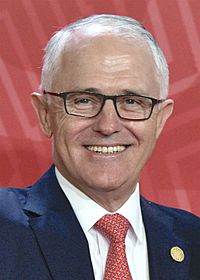 |
|
|
Premiership of Malcolm Turnbull
|
|
|---|---|
| 15 September 2015 – 24 August 2018 | |
| Elizabeth II | |
| Premier | Malcolm Turnbull |
| Cabinet | First Turnbull Ministry Second Turnbull Ministry |
| Party | Liberal Party |
| Election | 2016 |
| Appointer | Sir Peter Cosgrove |
| Seat | The Lodge (Canberra) Kirribilli House (Sydney) |
|
← Tony Abbott • Scott Morrison →
|
|
 |
|
| Coat of arms of Australia | |
Becoming Prime Minister
On 14 September 2015, Turnbull resigned from his role as Minister and announced he would challenge Tony Abbott for the leadership of the Liberal Party. He stated that Abbott was not providing the economic leadership Australia needed. Turnbull won the vote and became the 29th prime minister of Australia the next day.
As prime minister, Turnbull made changes to his Cabinet. He increased the number of women in Cabinet and appointed Marise Payne as Australia's first female Defence Minister. He also stated that his government would take climate change seriously.
2016 Federal Election
On 21 March 2016, Turnbull announced that if certain laws were rejected by Parliament for a third time, he would call an early federal election. The Senate rejected the laws again, and Turnbull called a double dissolution election for 2 July 2016.
During the election campaign, Turnbull faced some challenges in his own seat. At the election, the Liberal-National Coalition lost 14 seats but managed to keep a majority government by just one seat. This was a very close election. After the election, Turnbull had to work with independent Members of Parliament to ensure his government had enough support.
In February 2017, Turnbull confirmed he had donated a large sum of money to the Liberal Party's election campaign.
Asylum Seeker Policy

Australia's policy on asylum seekers is a complex issue. Turnbull's government continued the policy of processing asylum seekers offshore on Manus Island and Nauru. In 2016, Turnbull announced a deal with the United States. Australia would accept refugees from Central America, and in return, the U.S. would accept refugees from Nauru and Manus Island.
In January 2017, Turnbull had a phone conversation with U.S. President Donald Trump about this deal. Despite some initial concerns, the U.S. later confirmed it would honor the agreement.
Energy Policy
Since the 2016 election, the Turnbull government focused on energy policies. In response to energy shortages in March 2017, Malcolm Turnbull announced a major expansion of the Snowy Hydro scheme, which uses "pumped hydro" technology to store energy.
In April 2017, Turnbull announced that the government would place limits on how much liquified natural gas (LNG) companies could export. This was to ensure there was enough gas for Australia's own use and to help lower gas prices.
Same-Sex Marriage Vote
Before Turnbull became prime minister, the Liberal Party decided that the issue of same-sex marriage should be decided by a public vote. When laws for a formal vote were rejected by Parliament, the government decided to hold a postal survey. This survey asked Australians if they supported changing the definition of marriage.
The survey results were released on 15 November 2017, with 61.6% of people voting "Yes" to allow same-sex marriage. Following this vote, Parliament debated and passed a law on 7 December 2017, legalizing same-sex marriage in Australia. Turnbull himself voted "Yes" for the change. The first same-sex marriages in Australia happened from 9 January 2018.
Parliamentary Eligibility Issues
In 2017, several Members of Parliament faced issues with their eligibility to serve. This was due to a rule in the Australian Constitution that says a person cannot be a Member of Parliament if they are a citizen of another country. Some members of Turnbull's government, including Deputy Prime Minister Barnaby Joyce, were found to have dual citizenship and were disqualified from Parliament.
The Turnbull government temporarily lost its majority in Parliament because of these disqualifications. However, after giving up their foreign citizenships, both Joyce and another Liberal MP, John Alexander, successfully ran in special elections and won back their seats. This helped Turnbull's government regain its majority.
August 2018 Leadership Challenges
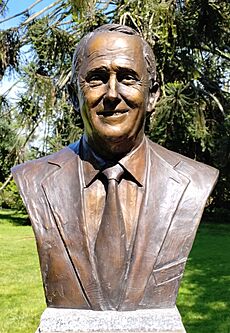
On 21 August 2018, Turnbull faced a challenge to his leadership of the Liberal Party from Peter Dutton. Turnbull won this vote. However, tensions continued within the party. On 24 August 2018, a second leadership vote was called. Turnbull decided not to run in this vote. Scott Morrison was then elected as the new leader of the Liberal Party and became prime minister.
On 27 August, Turnbull announced he would resign from Parliament. He officially left Parliament on 31 August 2018. This led to a special election in his former seat of Wentworth, which the Liberal Party lost to an independent candidate.
Political Views
Malcolm Turnbull is considered a moderate within the Liberal Party of Australia. He is often described as being practical and having centrist views, with progressive and socially liberal opinions. He has said that the Liberal Party was founded to be in the "sensible centre" of Australian politics. Since leaving politics, he has criticized the Liberal Party for what he sees as a shift towards more right-wing views.
Life After Politics
After leaving politics, Turnbull became a senior advisor for a global investment firm in 2019. He has also publicly criticized the Morrison government for not taking stronger action on climate change. He believes they should bring back his National Energy Guarantee policy.
In 2020, Turnbull supported a petition started by former Prime Minister Kevin Rudd. This petition called for an investigation into the influence of Rupert Murdoch's News Corp media company in Australia. The petition received a very large number of signatures.
In 2021, Turnbull joined the board of the International Hydropower Association, which focuses on pumped storage hydropower.
Personal Life
Turnbull is married to Lucy Turnbull (born Hughes). Lucy was the Lord Mayor of Sydney from 2003 to 2004 and has held other important roles. They were married in 1980 in England. They live in Sydney.
Malcolm and Lucy have two adult children, Alex and Daisy. As of July 2016, they have three grandchildren. The name "Bligh" is a traditional middle name for males in the Turnbull family.
Religion
Turnbull was raised in the Presbyterian faith. He later became agnostic before converting to Roman Catholicism around 2002. However, he has sometimes disagreed with the Catholic Church's views on certain social issues.
Personal Wealth
In 2005, Malcolm and Lucy Turnbull's combined wealth was estimated at A$133 million, making him Australia's richest Member of Parliament at the time. His estimated wealth continued to grow over the years.
Honours
On 1 January 2001, Turnbull received the Centenary Medal for his contributions to the business world. In 2021, he was awarded the Companion of the Order of Australia. This honour recognized his significant service to Australia as Prime Minister, especially for his work on national security, free trade, the environment, clean energy, innovation, economic reform, and marriage equality.
See also
 In Spanish: Malcolm Turnbull para niños
In Spanish: Malcolm Turnbull para niños
- 2016 Australian federal election
- Turnbull government
- First Turnbull ministry
- Second Turnbull ministry


